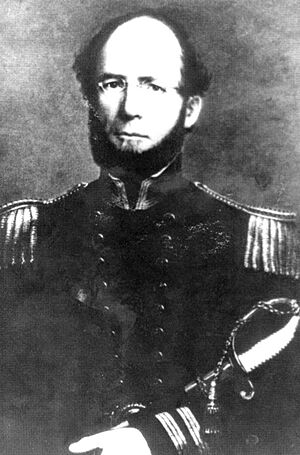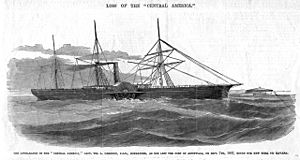William Lewis Herndon facts for kids
William Lewis Herndon (born October 25, 1813 – died September 12, 1857) was a brave and skilled explorer and sailor in the United States Navy. He is remembered for leading an important expedition to the Valley of the Amazon in 1851. He wrote a detailed report about his journey, which was published in 1854 as Exploration of the Valley of the Amazon.
Herndon is especially famous for saving 152 women and children. This happened when he was commanding the mail ship Central America in September 1857. The ship got caught in a huge hurricane off the coast of North Carolina. Even though the ship was sinking, Herndon made sure many people got safely onto another vessel. He chose to stay with his ship, and sadly, he went down with it. More than 400 passengers and crew members were lost when the ship sank near Cape Hatteras. This was one of the biggest losses of life in a commercial ship disaster in U.S. history.

Two years after his death, his daughter, Ellen Lewis Herndon, married Chester A. Arthur. Chester Arthur later became a U.S. president.
Contents
Early Life and Family Connections
William Lewis Herndon was born in Fredericksburg, Virginia. He married Frances Elizabeth Hansborough. They had one daughter, Ellen Lewis Herndon, who was born in Culpeper, Virginia. Ellen later married Chester A. Arthur, who became a President of the United States. Herndon's great-niece was a writer named Lucy Herndon Crockett.
William Herndon joined the Navy as a midshipman on November 1, 1828. He was promoted to passed midshipman in 1834 and then to lieutenant in 1841. Before 1842, he sailed in many different parts of the world. These included the Pacific Ocean, South America, the Mediterranean Sea, and the Gulf of Mexico.
From 1842 to 1846, Herndon worked at the United States Naval Observatory. This was a place where they made maps and studied the stars. He worked with his cousin, Matthew Fontaine Maury. They created important ocean maps and did other scientific work. These maps helped ships navigate the seas safely and accurately.
During the Mexican–American War, Herndon showed great skill. He was in charge of a ship called the brig Iris.
Exploring the Amazon River Valley
In 1851, Herndon led an important journey to explore the Valley of the Amazon. This was a huge area that Europeans had not mapped much. However, many different groups of native people had lived there for thousands of years. The main goal of Herndon's trip was to find out what natural resources were in the valley. They also wanted to see how the area could be used for trade.
Herndon started his journey from Lima, Peru, on May 21, 1851. He traveled with Lieutenant Lardner Gibbon and five other men. They pushed deep into the thick jungles. After crossing the Cordilleras mountains, Gibbon went off to explore rivers in Bolivia that flowed into the Amazon. Herndon continued to explore the main part of the Amazon River. After traveling 4,366 miles, Herndon reached the city of Pará, Brazil, on April 11, 1852. His journey took him from sea level to very high places, up to 16,199 feet.
On January 26, 1853, Herndon gave a detailed report to the Secretary of the Navy, John P. Kennedy. This report was 414 pages long and included many pictures. The Navy published it in 1854 as Exploration of the Valley of the Amazon. The Navy even ordered 10,000 extra copies to be printed. The report was shared widely and used in books about people and nature.
The Sinking of the SS Central America
After serving on two other Navy ships, Herndon was given a new command in 1855. He became the commander of the steamer SS Central America. This ship sailed from New York to Aspinwall, Panama. Navy captains were often put in charge of these mail ships. These ships carried large amounts of gold from California to cities on the East Coast. They also took gold to the United States Mint in Philadelphia.
Herndon's ship was carrying about 15 tons of gold. This gold was worth $2,000,000 at the time. There were also 474 passengers on board, many of whom were returning home from California. The ship had 101 crew members too. A few days after leaving Cuba on September 7, 1857, the ship ran into a terrible hurricane. The storm lasted for three days near Cape Hatteras.
By September 12, the Central America was taking on a lot of water. The ship was not built to be very strong against leaks. Water in the ship's lower parts put out the boiler fires. This meant the ship lost its power to move and pump out water.
Herndon knew his ship was in great danger. He raised the ship's flag upside down as a sign of distress. He hoped another ship would see them. At 2 p.m., another ship, the Marine, arrived to help. But the Marine did not have enough room for everyone. Commander Herndon carefully oversaw the difficult task of moving women and children into lifeboats. They were then transferred to the Marine. He gave his watch to one of the women passengers. He asked her to give it to his wife. He said he could not leave the ship while anyone was still on board. Most of the women and children were saved by reaching the Marine. Herndon's care for his passengers helped save 152 of the 575 people on board.
The men who stayed on the Central America tried to make floats from wooden parts of the ship. Some were later rescued by other ships that passed by. But most of the 423 people on board died when the ship sank. This was the biggest loss of life for a commercial ship in U.S. history. Survivors said they last saw Commander Herndon in his full uniform. He was standing by the ship's steering area, holding his hat, with his head bowed in prayer. Then the ship tilted and sank.
The sinking of the ship and the loss of so much gold caused a financial problem in the United States. This event contributed to the Panic of 1857. The wreckage of the ship was found in 1987 by a team looking for treasure.
Herndon's Legacy
William Lewis Herndon is remembered in several ways:
- His fellow Navy officers built the Herndon Monument in his honor at the U.S. Naval Academy.
- The Navy has named two ships USS Herndon after him.
- The towns of Herndon, Virginia, and Herndon, Pennsylvania, are also named for him.
Images for kids






